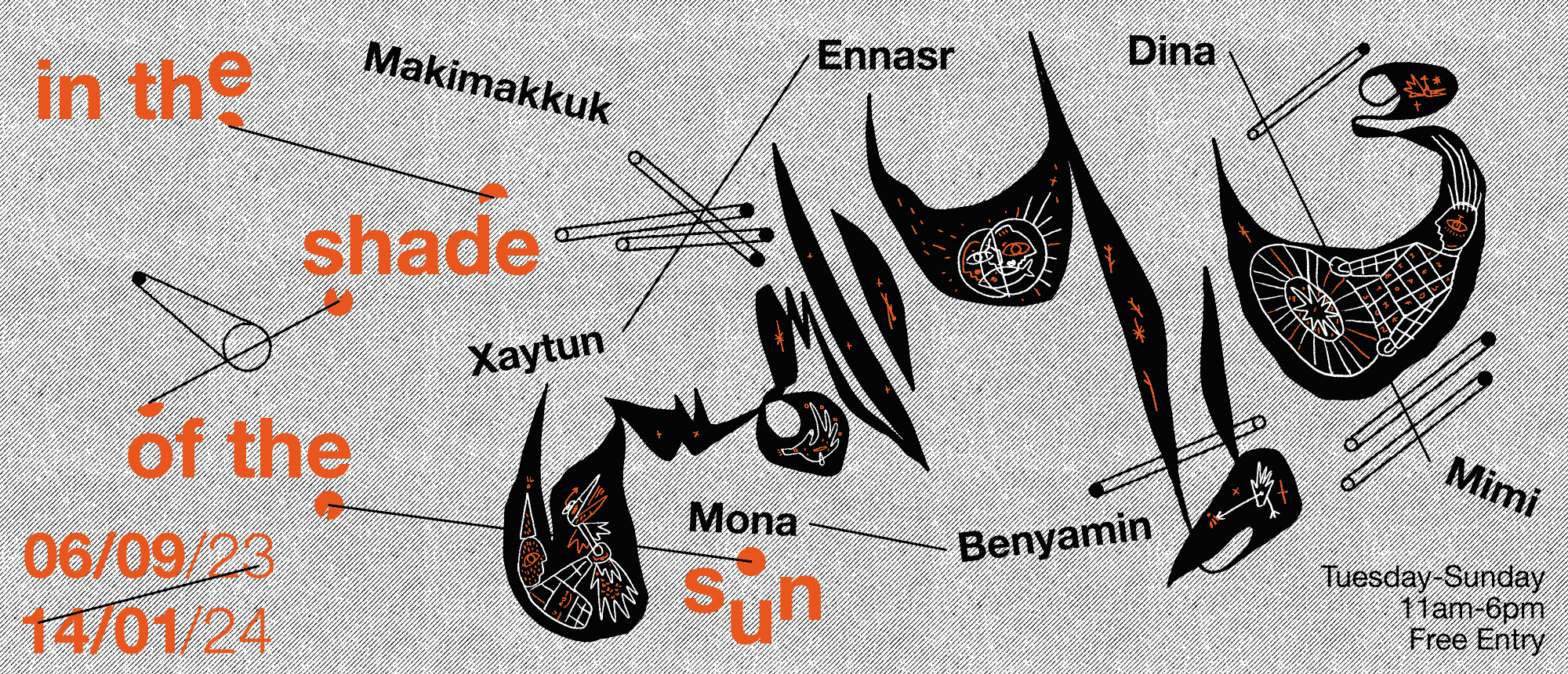
Poster design: Studio Mnjnk
In the shade of the sun brings together new commissions from Mona Benyamin, Xaytun Ennasr, Dina Mimi and Makimakkuk at The Mosaic Rooms in London. Each of these artists are forging an entirely new language to think about and with Palestine. Their practices are connected in a radical politics, finding expressions in seemingly soft forms, absurd images, and poetic wanderings.
Adam HajYahia was invited by Bilna’es to curate the public program, he writes:
Bilna’es is the Arabic word for ‘in the negative’. The term evokes a politics of being and producing from within the moment of catastrophe, forging from beyond it, the multitude of possibilities across the impossible. This public programme borrows from this methodology to consider the potentialities that could materialise in the cracks of the crises of the present.
يقدم معرض "في ظل الشمس" تكليفات فنيّة جديدة من الفنانينات منى بنيامين وزيتون النصر ودينا ميمي وماكيماكوك في الموزايك رومز (Mosaic Rooms) في لندن. يقوم كل واحد من الفنانين بصياغة لغة جديدة تمامًا للتفكير حول فلسطين ومعها. ترتبط ممارساتهم بالسياسة الجذرية حيث يجدون تعبيرات في أشكال تبدو ناعمة، وصور متناقضة، وتجولات شعرية.
تمت دعوت آدم حاج يحيى من قبل بالناقص لإشراف البرنامج العام، فكتب:
بالناقص هي الكلمة العربية التي تعني ''في النفي'. يستحضر المصطلح سياسة الوجود والإنتاج من داخل لحظة الكارثة، وصياغة من وراءها، العديد من الاحتمالات عبر المستحيل. ويستمد هذا البرنامج العام من هذه المنهجية لاستكشاف الإمكانيات التي يمكن أن تتجسد في شقوق أزمات الحاضر.
In the shade of the sun
Mona Benyamin, Xaytun Ennasr, Makimakkuk, Dina Mimi
6/09/23—14/01/24
In the shade of the sun brings together new commissions from Mona Benyamin, Xaytun Ennasr, Dina Mimi and Makimakkuk at The Mosaic Rooms in London. Each of these artists are forging an entirely new language to think about and with Palestine. Their practices are connected in a radical politics, finding expressions in seemingly soft forms, absurd images, and poetic wanderings.
Adam HajYahia was invited by Bilna’es to curate the public program, he writes:
The public programming for In the shade of the sun builds on what Bilna’es’ exhibition conception already proposes. Methodologically, we need to radically rethink the formulations within which cultural and artistic work is produced, circulated, and consumed. For the burdensome demands of the art market and industry, the invisibilised labour of artists and cultural workers, as well as hierarchies and mediation configurations as we know them, are not conducive to thriving and sustainable futures. Aesthetically, and therefore politically, there is a need to continue the search for a new language to tackle the particularities of our present fascist neoliberal predicaments while also devising alternative assemblages, economies, and relations for an otherwise.
Bilna’es is the Arabic word for ‘in the negative’. The term evokes a politics of being and producing from within the moment of catastrophe, forging from beyond it, the multitude of possibilities across the impossible. This public programme borrows from this methodology to consider the potentialities that could materialise in the cracks of the crises of the present.
يقدم معرض "في ظل الشمس" تكليفات فنيّة جديدة من الفنانينات منى بنيامين وزيتون النصر ودينا ميمي وماكيماكوك في الموزايك رومز (Mosaic Rooms) في لندن. يقوم كل واحد من الفنانين بصياغة لغة جديدة تمامًا للتفكير حول فلسطين ومعها. ترتبط ممارساتهم بالسياسة الجذرية حيث يجدون تعبيرات في أشكال تبدو ناعمة، وصور متناقضة، وتجولات شعرية.
تمت دعوت آدم حاج يحيى من قبل بالناقص لإشراف البرنامج العام، فكتب:
يعتمد البرامج العام لمعرض "في ظل الشمس" على المفهوم ذاته الذي يقترحه بالناقص. ومن الناحية المنهجية، نحتاج إلى إعادة التفكير بشكل جذري في الصياغات التي يتم من خلالها إنتاج العمل الثقافي والفني وتعميمه واستهلاكه. بالنسبة للمتطلبات المرهقة لسوق الفن وصناعته، فإن العمل غير المرئي للفنانين والعاملين في مجال الثقافة، فضلاً عن التسلسلات الهرمية وتكوينات الوساطة كما نعرفها، لا يفضي إلى مستقبل مزدهر ومستدام. من الناحية الجمالية، وبالتالي السياسية، هناك حاجة لمواصلة البحث عن لغة جديدة لمعالجة خصوصيات مآزقنا النيوليبرالية الفاشية الحالية مع ابتكار تجمعات واقتصادات وعلاقات بديلة لطريقة أخرى.
بالناقص هي الكلمة العربية التي تعني ''في النفي'. يستحضر المصطلح سياسة الوجود والإنتاج من داخل لحظة الكارثة، وصياغة من وراءها، العديد من الاحتمالات عبر المستحيل. ويستمد هذا البرنامج العام من هذه المنهجية لاستكشاف الإمكانيات التي يمكن أن تتجسد في شقوق أزمات الحاضر.





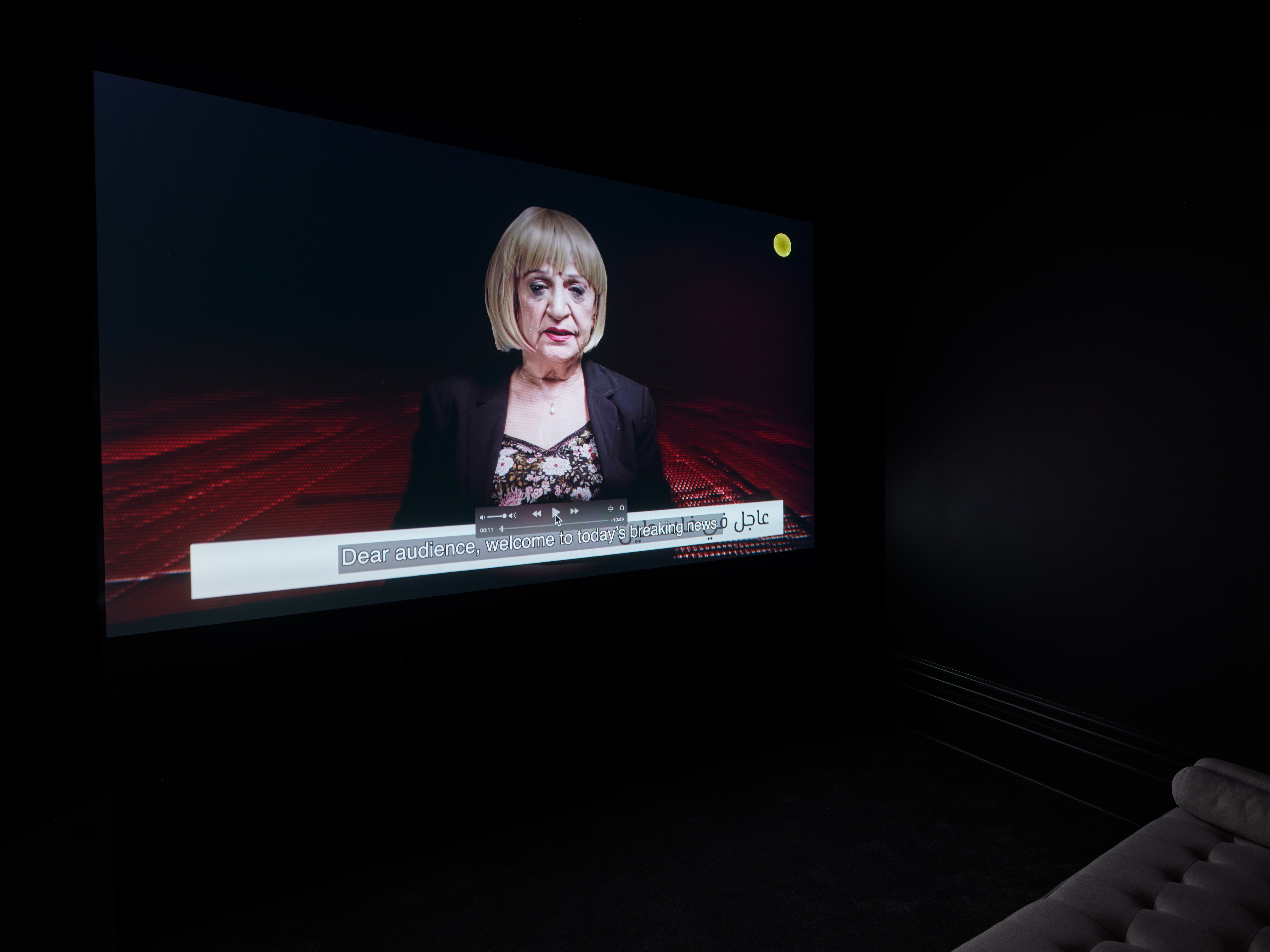

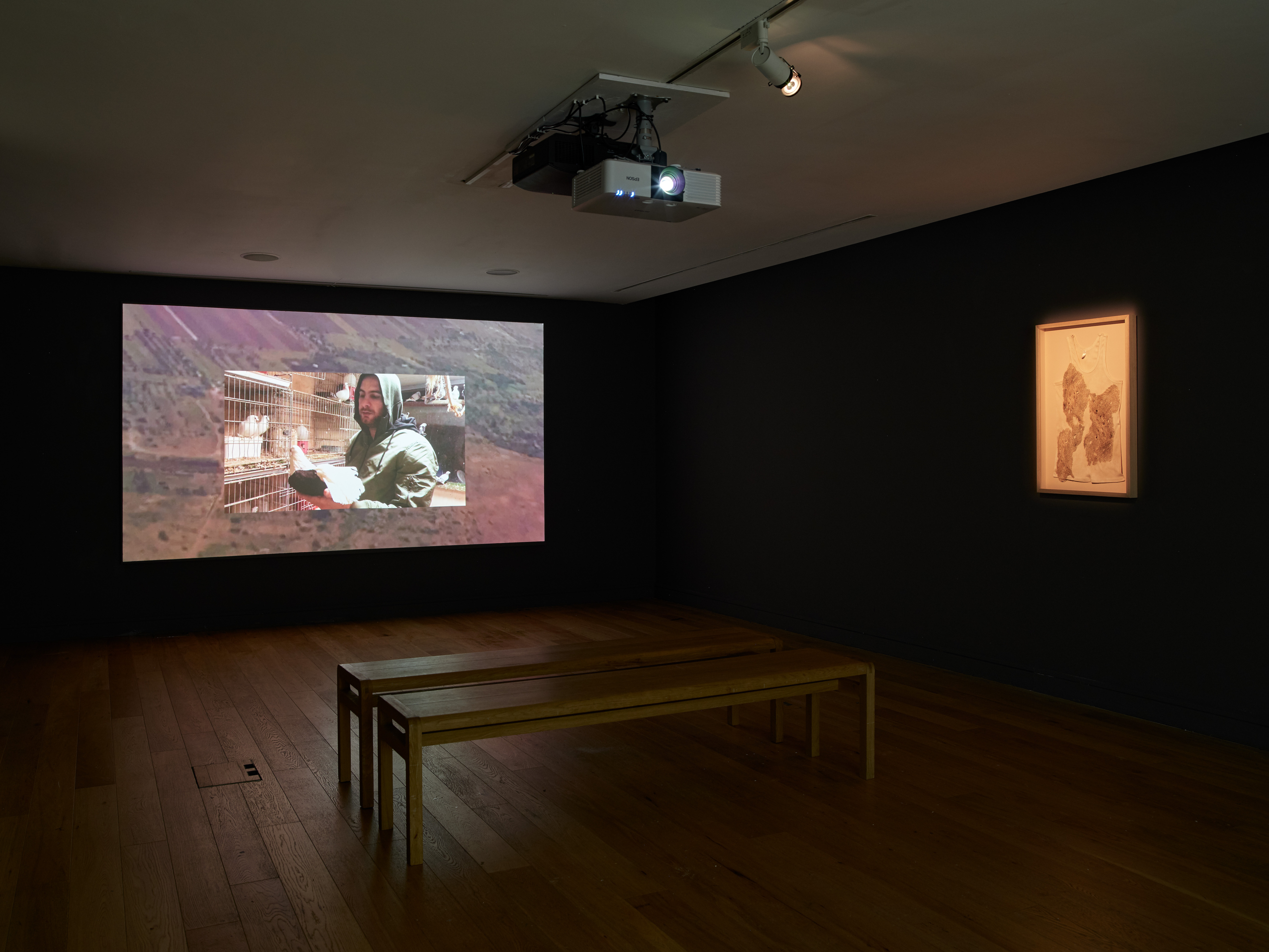


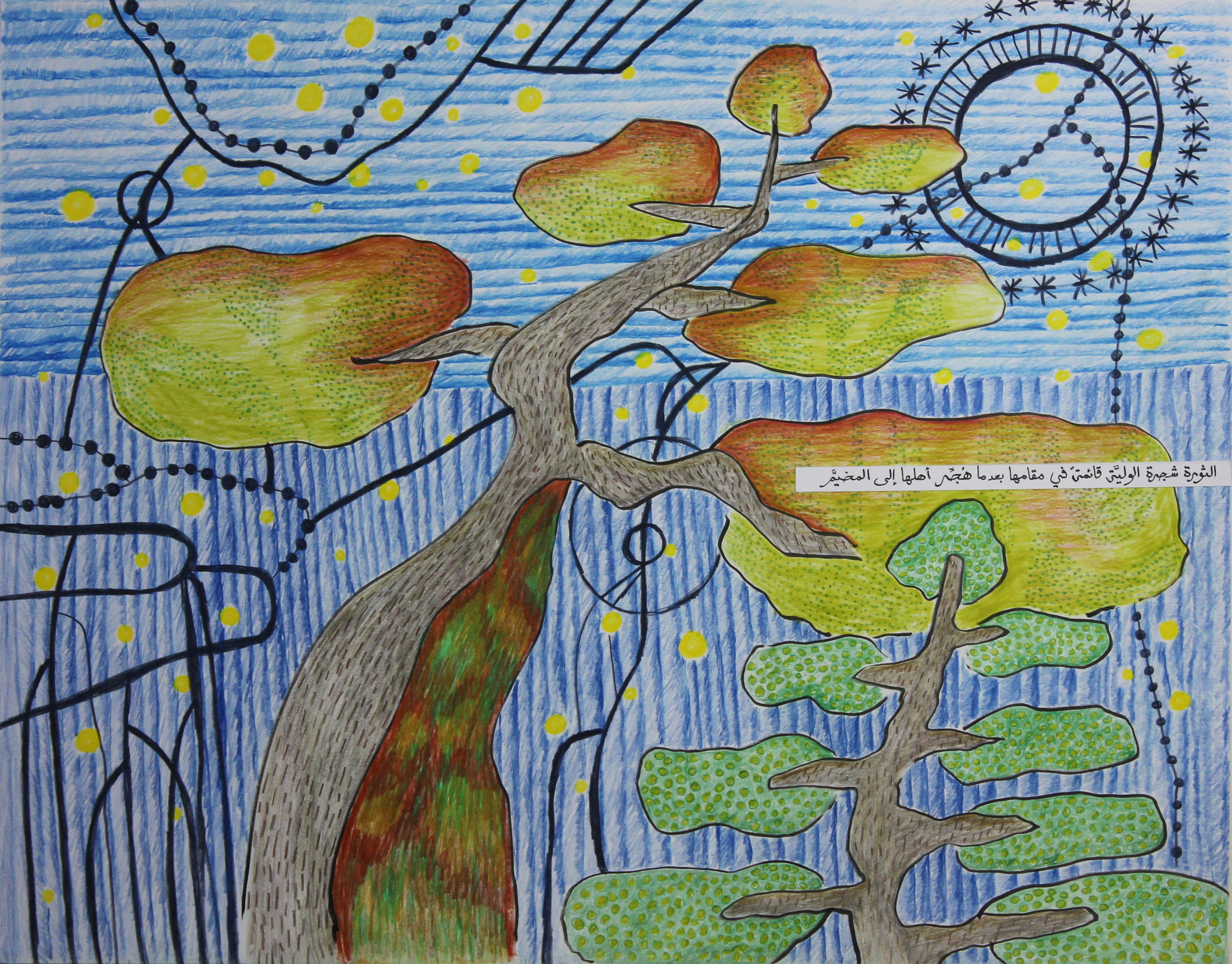
Dina Mimi (@___sa3lok), The melancholy of this useless afternoon
Dina Mimi’s project The melancholy of this useless afternoon unfolds through two chapters reflecting on the role of the fugitive and the smuggler. Chapter I layers images of birdsong competitions, revolutionary songs from Oman, Yemen and Palestine with a narrative contemplating movement, loss, separation, and revolutionary practice. Chapter II employs a clandestine style to document the practice of bird smuggling and the part the human body plays in this act. These are accompanied by a framed vest with an organic material resembling what the birds are traditionally hidden within.
Dina Mimi is a visual artist who lives and works in Jerusalem. Her practice is multifaceted and uses video, sound, performance, and text. Dina has been researching issues and subjects regarding the body and death in the public sphere, and notions of visibility and invisibility in the relation of archaeology to the object, and the museum to death. She has also been researching protest as a performance. Her work examines the role of the body-force in public space in Palestine.
Dina Mimi’s project The melancholy of this useless afternoon unfolds through two chapters reflecting on the role of the fugitive and the smuggler. Chapter I layers images of birdsong competitions, revolutionary songs from Oman, Yemen and Palestine with a narrative contemplating movement, loss, separation, and revolutionary practice. Chapter II employs a clandestine style to document the practice of bird smuggling and the part the human body plays in this act. These are accompanied by a framed vest with an organic material resembling what the birds are traditionally hidden within.
Dina Mimi is a visual artist who lives and works in Jerusalem. Her practice is multifaceted and uses video, sound, performance, and text. Dina has been researching issues and subjects regarding the body and death in the public sphere, and notions of visibility and invisibility in the relation of archaeology to the object, and the museum to death. She has also been researching protest as a performance. Her work examines the role of the body-force in public space in Palestine.
دينا ميمي، حزن هذا العصر البائس
يُعرض في لندن حتى 14 يناير 2024
ينكشف حزن هذا العصر البائس من خلال فصلين يعكسان دور الهارب والمهرب. الفصل الأول يتضمن صورًا لمسابقات غناء الطيور وأغاني الثورة من عمان واليمن وفلسطين مع سرد يتأمل في الحركة والفقدان والانفصال والممارسة الثورية. الفصل الثاني يستخدم أسلوبًا سريًا لوثائق ممارسة تهريب الطيور والدور الذي يلعبه الجسم البشري في هذا الفعل. يرافق ذلك بستان عضوي يشبه المادة التي يتم تقديم الطيور داخلها تقليديًا.
دينا ميمي هي فنانة بصرية تعيش وتعمل في القدس. ممارستها متعددة الجوانب، تستخدم الفيديو، والصوت، والأداء، والنص. تبحث دينا في قضايا ومواضيع تتعلق بالجسد والموت في الفضاء العام، وكذلك في مفاهيم الظهور والاختفاء في علاقة علم الآثار بالشيء، وعلاقة المتحف بالموت. كما أنها بحثت في الاحتجاج بوصفه شكلاً من أشكال الأداء. أعمالها تفحص دور الجسد-القوة في الفضاء العام في فلسطين.
يُعرض في لندن حتى 14 يناير 2024
ينكشف حزن هذا العصر البائس من خلال فصلين يعكسان دور الهارب والمهرب. الفصل الأول يتضمن صورًا لمسابقات غناء الطيور وأغاني الثورة من عمان واليمن وفلسطين مع سرد يتأمل في الحركة والفقدان والانفصال والممارسة الثورية. الفصل الثاني يستخدم أسلوبًا سريًا لوثائق ممارسة تهريب الطيور والدور الذي يلعبه الجسم البشري في هذا الفعل. يرافق ذلك بستان عضوي يشبه المادة التي يتم تقديم الطيور داخلها تقليديًا.
دينا ميمي هي فنانة بصرية تعيش وتعمل في القدس. ممارستها متعددة الجوانب، تستخدم الفيديو، والصوت، والأداء، والنص. تبحث دينا في قضايا ومواضيع تتعلق بالجسد والموت في الفضاء العام، وكذلك في مفاهيم الظهور والاختفاء في علاقة علم الآثار بالشيء، وعلاقة المتحف بالموت. كما أنها بحثت في الاحتجاج بوصفه شكلاً من أشكال الأداء. أعمالها تفحص دور الجسد-القوة في الفضاء العام في فلسطين.
In their multimedia installation, Revolution is a forest that the colonist can’t burn, Xaytun Ennasr celebrates trees as symbols of resistance and devotion. Through the artist’s aesthetic of radical softness, the installation examines what a revolutionary relationship with nature looks like. Trees are situated not as resources waiting to be extracted but as beings that are loved and that love back. That relationship is presented through a variety of media, including drawings, poetry, ceramics, textiles, living olive and fig trees, and an interactive digital game.
Xaytun Ennasr’s work as a multidisciplinary artist is centered around the liberation of Palestine, radical softness, and revolutionary cultural production. They use a variety of mediums including videogames, drawings, ceramics, installation, and text to start a conversation around a world that transcends beyond the oppressive capitalism, colonialism, and patriarchal reality of the one we currently occupy.
Xaytun Ennasr’s work as a multidisciplinary artist is centered around the liberation of Palestine, radical softness, and revolutionary cultural production. They use a variety of mediums including videogames, drawings, ceramics, installation, and text to start a conversation around a world that transcends beyond the oppressive capitalism, colonialism, and patriarchal reality of the one we currently occupy.
زيتون النصر، الثورة غابة ليس بوسع المستعمر حرقها
في عملها التركيبي ‘الثورة غابة ليس بوسع المستعمر حرقها‘, تحتفي زيتون النصر بالأشجار كرموز للمقاومة والتفاني. يفحص العمل علاقة الثورة مع الطبيعة من خلال الجمالية الجذرية للنعومة والرّقة. تلك الأشجار ليست موجودة كمجرّد موارد في انتظار استخراجها، بل هي كائنات حيّة تُحبّ وتحبّ بالمقابل. تجسّد هذه العلاقة من خلال مجموعة من الوسائط الفنية، كالرسومات والشّعر والسيراميك والنسيج وأشجار الزيتون والتين الحيّة بالاضافة الى لعبة تفاعلية رقمية.
يتمحور عمل زيتون النصر كفنانة متعددة التخصصات حول موضوع تحرير فلسطين، والنعومة الجذرية، والإنتاج الثقافي الثوري. يستخدمون مجموعة متنوعة من الوسائط بما في ذلك ألعاب الفيديو والرسومات والسيراميك والأعمال التركيبية والنصوص لبدء محادثة حول عالم يتجاوز الرأسمالية القمعية والاستعمار والواقع الأبوي للعالم الذي نحتله حاليًا.
في عملها التركيبي ‘الثورة غابة ليس بوسع المستعمر حرقها‘, تحتفي زيتون النصر بالأشجار كرموز للمقاومة والتفاني. يفحص العمل علاقة الثورة مع الطبيعة من خلال الجمالية الجذرية للنعومة والرّقة. تلك الأشجار ليست موجودة كمجرّد موارد في انتظار استخراجها، بل هي كائنات حيّة تُحبّ وتحبّ بالمقابل. تجسّد هذه العلاقة من خلال مجموعة من الوسائط الفنية، كالرسومات والشّعر والسيراميك والنسيج وأشجار الزيتون والتين الحيّة بالاضافة الى لعبة تفاعلية رقمية.
يتمحور عمل زيتون النصر كفنانة متعددة التخصصات حول موضوع تحرير فلسطين، والنعومة الجذرية، والإنتاج الثقافي الثوري. يستخدمون مجموعة متنوعة من الوسائط بما في ذلك ألعاب الفيديو والرسومات والسيراميك والأعمال التركيبية والنصوص لبدء محادثة حول عالم يتجاوز الرأسمالية القمعية والاستعمار والواقع الأبوي للعالم الذي نحتله حاليًا.



Mona Benyamin, Tomorrow, Again
Tomorrow, Again, by Mona Benyamin stages a dysfunctional news broadcast that consists of different segments which recreate and react to various prominent daily catastrophes from Palestine. Instead of a spoken narrative, the film resorts to exaggerated emotional and physical displays. It utilises fragmented and often conflicting testimonies, doppelgängers, and a surrealist visual language to draw on notions of truth and fiction, and differing temporalities. The cast of the film sees two protagonists, the artist’s parents, assume multiple identities as they narrate and consume their own stories in an endless cycle.
Tomorrow, Again, by Mona Benyamin stages a dysfunctional news broadcast that consists of different segments which recreate and react to various prominent daily catastrophes from Palestine. Instead of a spoken narrative, the film resorts to exaggerated emotional and physical displays. It utilises fragmented and often conflicting testimonies, doppelgängers, and a surrealist visual language to draw on notions of truth and fiction, and differing temporalities. The cast of the film sees two protagonists, the artist’s parents, assume multiple identities as they narrate and consume their own stories in an endless cycle.
منى بنيامين، غدًا مرّة أخرى
يقدم فيلم غدًا مرة أخرى، من إخراج منى بنيامين، بثًا إخباريًا مختلًا يتكّون من مقاطع مختلفة تعيد خلق مختلف الكوارث اليومية البارزة في فلسطين وتتفاعل معها. بدلاً من السرد المحكي، يلجأ الفيلم إلى عروض عاطفية وجسدية مبالغ فيها. يستخدم شهادات مجزأة وغالباً متضاربة ، وأشخاص مشابهين ، ولغة بصرية سريالية لاستنتاج مفاهيم الحقيقة والخيال، والأزمنة المؤقتة المختلفة. يرى طاقم الفيلم أن البطلين، والدي الفنانة، يتخذان هويات متعددة بينما يرويان ويستهلكان قصصهما الخاصة في
دورة لا نهاية لها.
يقدم فيلم غدًا مرة أخرى، من إخراج منى بنيامين، بثًا إخباريًا مختلًا يتكّون من مقاطع مختلفة تعيد خلق مختلف الكوارث اليومية البارزة في فلسطين وتتفاعل معها. بدلاً من السرد المحكي، يلجأ الفيلم إلى عروض عاطفية وجسدية مبالغ فيها. يستخدم شهادات مجزأة وغالباً متضاربة ، وأشخاص مشابهين ، ولغة بصرية سريالية لاستنتاج مفاهيم الحقيقة والخيال، والأزمنة المؤقتة المختلفة. يرى طاقم الفيلم أن البطلين، والدي الفنانة، يتخذان هويات متعددة بينما يرويان ويستهلكان قصصهما الخاصة في
دورة لا نهاية لها.
Makimakkuk (@makimakkuk), What remains in the museum
Sonic Live Performance (Canceled)
Makimakkuk was set to debut a newly commissioned sound work titled What remains in the museum. The multi-layered work was meant to sonically reflect on identity, colonisation, love and relationships. It was set to be performed singularly live in the exhibition during a special event.
كانت ستقدم ماكيمكّوك عملاً صوتيًا تم تكليفه حديثًا بعنوان ما بقي في المتحف. كان المقصود من العمل متعدد الطبقات أن يعكس صوتيًا الهوية والاستعمار والحب والعلاقات. وكان من المفترض أن يتم العرض في المعرض خلال فعالية خاصة ضمن البرنامج العام.
Sonic Live Performance (Canceled)
Makimakkuk was set to debut a newly commissioned sound work titled What remains in the museum. The multi-layered work was meant to sonically reflect on identity, colonisation, love and relationships. It was set to be performed singularly live in the exhibition during a special event.
ماكيمكّوك، ما بقي في المتحف
آداء حي، (ملغى)
آداء حي، (ملغى)
كانت ستقدم ماكيمكّوك عملاً صوتيًا تم تكليفه حديثًا بعنوان ما بقي في المتحف. كان المقصود من العمل متعدد الطبقات أن يعكس صوتيًا الهوية والاستعمار والحب والعلاقات. وكان من المفترض أن يتم العرض في المعرض خلال فعالية خاصة ضمن البرنامج العام.
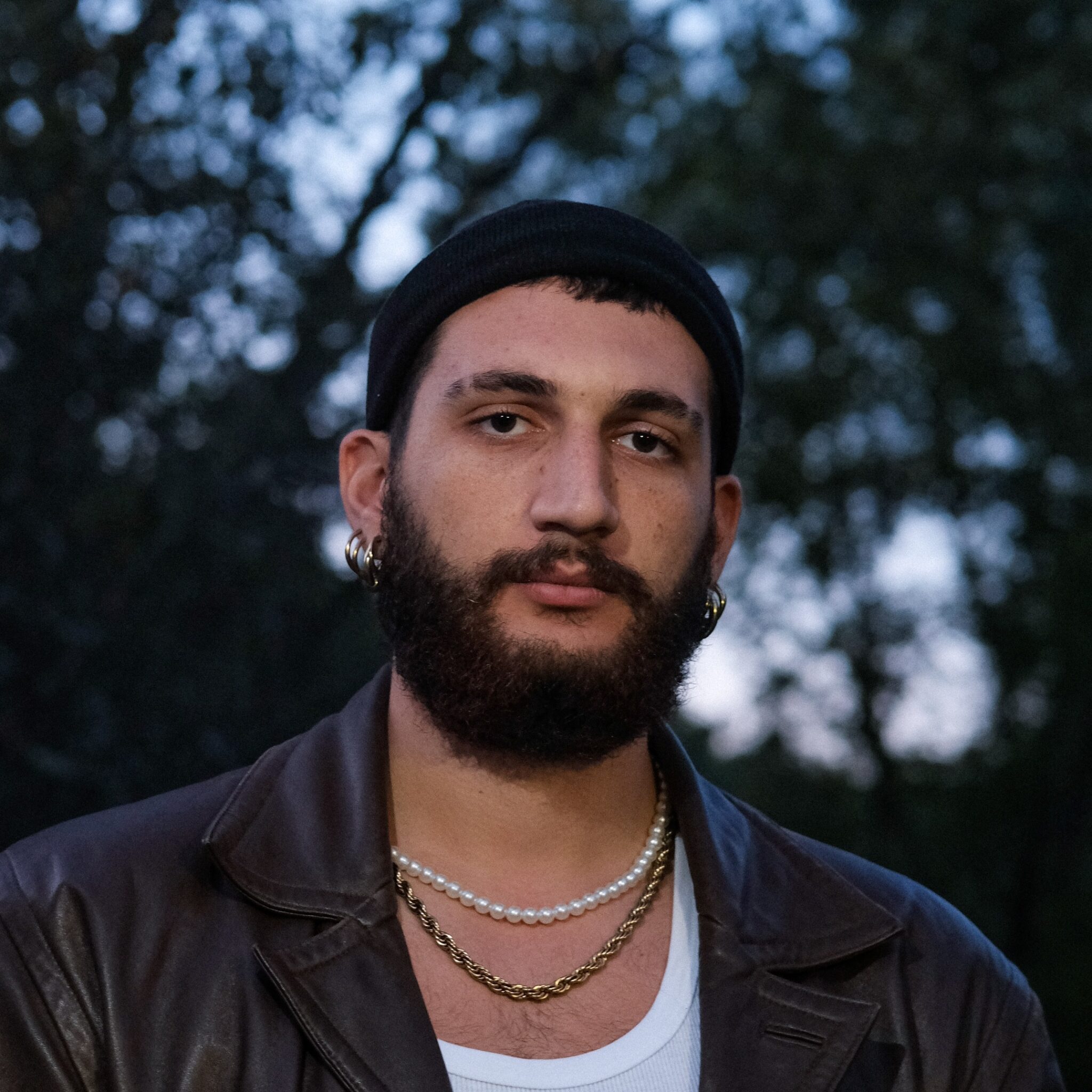
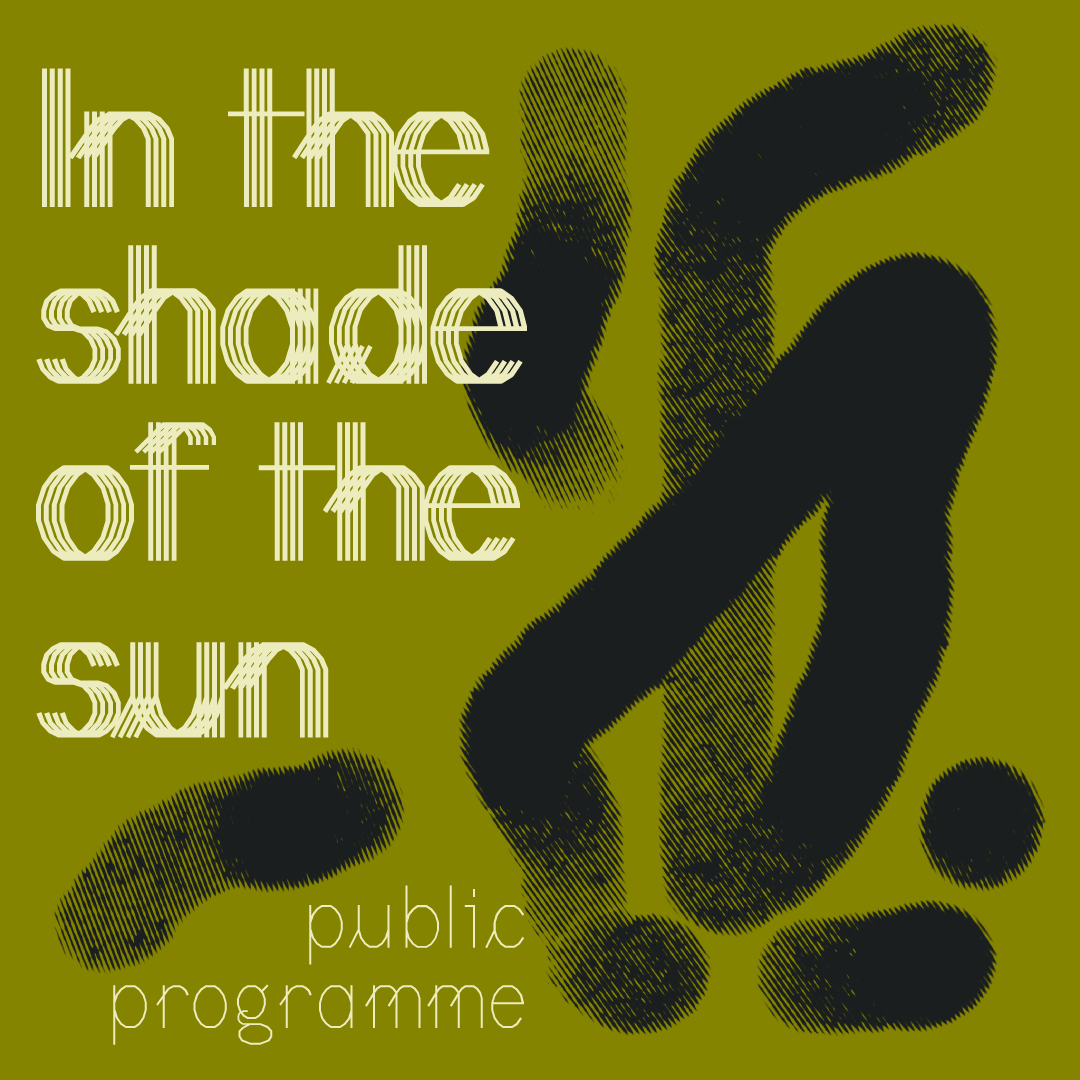
Adam HajYahia (@kimikku) has been specially invited by Bilna’es to co-curate the exhibition’s accompanying public programme.
HajYahia is an independent researcher, curator, and culture producer. He is from Haifa, Palestine. Adam’s research interests revolve around structural an is hierarchical violence, and its intersections with capitalist, colonial, sexual, and social dynamics in Palestine and beyond.
HajYahia is an independent researcher, curator, and culture producer. He is from Haifa, Palestine. Adam’s research interests revolve around structural an is hierarchical violence, and its intersections with capitalist, colonial, sexual, and social dynamics in Palestine and beyond.
تمت دعوة آدم حاج يحيى خصيصًا من قبل بالناقص للمشاركة في الإشراف على البرنامج العام المصاحب للمعرض.
الحاج يحيى هو باحث مستقل، وقيّم متحف، ومنتج ثقافي. وهو من حيفا، فلسطين. تتمحور اهتمامات آدم البحثية حول العنف الهيكلي الهرمي، وتقاطعاته مع الديناميكيات الرأسمالية والاستعمارية والجنسية والاجتماعية في فلسطين وخارجها.
الحاج يحيى هو باحث مستقل، وقيّم متحف، ومنتج ثقافي. وهو من حيفا، فلسطين. تتمحور اهتمامات آدم البحثية حول العنف الهيكلي الهرمي، وتقاطعاته مع الديناميكيات الرأسمالية والاستعمارية والجنسية والاجتماعية في فلسطين وخارجها.
